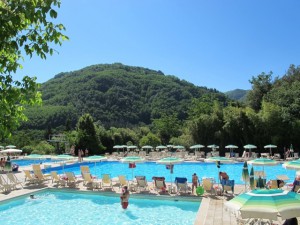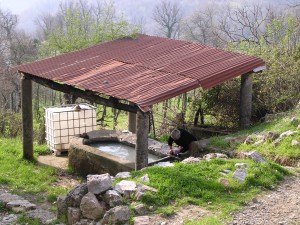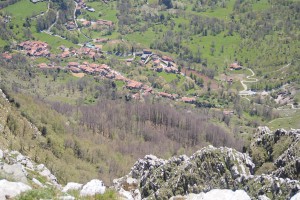Bathing
Villa Ada Pool
 In Bagni di Lucca (Villa), an outdoor swimming pool complex has been established in the garden of one of the old thermal baths – Villa Ada. It has a swimming pool, a children’s pool and a separate plunging pool. Poolside there are rest chairs, and a bar is selling food and refreshments.
In Bagni di Lucca (Villa), an outdoor swimming pool complex has been established in the garden of one of the old thermal baths – Villa Ada. It has a swimming pool, a children’s pool and a separate plunging pool. Poolside there are rest chairs, and a bar is selling food and refreshments.
Thermal baths
Further west in Bagni di Lucca, from Ponte a Serraglio, the road goes up to Bagni Caldi with the thermal baths, “Terme Jean Varraud”. They offer a wide range of different spa treatments and massages. For a sauna addict like myself, the hot caves is the favorite treat.
More info can be found on their own web site.
River bathing
The river Lima, the one running through Bagni di Lucca, is also popular for bathing – east (upstream) of Bagni, that is. There are several places where you can easily get access to the river, one is just across the narrow Ponte Maggio at Giardinetto (on the road to Casoli).
Riviera
And the Italian riviera is not far – a couple of hours driving and you are in the Versilia area, with classical beach towns like Viareggio, Forte dei Marmi, Lido di Camaiore and more…
Marina di Pisa
Even closer is the small town of Marina di Pisa, which less “upper nose” than the riviera. Be sure to get on the south side of the river Arno when you leave Pisa for Marina di Pisa – there is no crossing further out. Nice public beaches, some paid bathing establishments if you prefer, and good seafood restaurants.
Hiking
Col di Carpaneta
 Our very local “morning walk”, starting from the house, takes you up to about 830 meters above sea level in about an hour. It is partly quite steep, and follows unpaved mountain roads.
Our very local “morning walk”, starting from the house, takes you up to about 830 meters above sea level in about an hour. It is partly quite steep, and follows unpaved mountain roads.
From the house, go past the parking lot down to the main road. Continue for a few meters – besides a garage, take the concrete paved road up to the right. It will soon convert to a grass covered path, leading you up to the hamlet of Cembroni. When there, take the first road up to the right, and follow it to the top. Turn left, passing close to a few houses – the road again takes the form of a grass covered path. Passing a water basin on your left (see picture), the path will join a gravel road, soon bringing you up to the small chapel of Barburatico where the road splits. Follow the road to the right, and it will bring you first to Col di Ferraio with the crucifix, and further to Col di Carpaneta with a small chapel (in which there is a guest book which you are welcome to sign).
Needless to say, the daily morning walk usually returns the same way back. However, you may continue from this point, making for a longer tour. Either, you can crawl straight up barely visible paths along the mountain ridge to get to the top of Mt. Prato Fiorito. Or, you can continue along the dirt road, which now goes steep downwards. Eventually, this road will take you to Foce al Lago – with another crucifix – on the other side of the mountain, where you continue down to Albereta (near Montefegatesi) and then the main road home. Warning: This is a long walk of at least seven hours, and walking the last part on a hard paved road can be very tiresome.
Albereta, Foce al Lago and Mt. Prato Fiorito
 A less tiresome approach to some of the same areas is to drive to Albereta (see directions for Montefegatesi on the Sights page). Park at Albereta and walk the road up to the right – after a few meters the tarmac ends and you have a nice dirt road between shading tree. After about an hour, you arrive at Foce al Lago (with the crucifix). In the summer, at least in the weekends, here will usually be a (somewhat makeshift) bar service, called “Capannina Rossa”, serving coffee, water, wine, sausages etc.
A less tiresome approach to some of the same areas is to drive to Albereta (see directions for Montefegatesi on the Sights page). Park at Albereta and walk the road up to the right – after a few meters the tarmac ends and you have a nice dirt road between shading tree. After about an hour, you arrive at Foce al Lago (with the crucifix). In the summer, at least in the weekends, here will usually be a (somewhat makeshift) bar service, called “Capannina Rossa”, serving coffee, water, wine, sausages etc.
Depending on your wishes, it is usually possible to drive all the way up to Foce al Lago (at your own risk), to make it a shorter walk.
To the right you find Mt. Prato Fiorito – and a good path going to the top of it. When on the top, you can continue a few meters down on the other side, close to the edge the view is fantastic and right below your feet is San Cassiano. Yes, actually you are almost home – but beware not to take the shortcut 😉
Fontana di Troghi
From Foce al Lago, instead of turning right towards Prato Fiorito, you can take the signed path no 12 to the left. This leads you to the cottage at Fontana di Troghi in approx two hours. There are probably no services available at the cottage. The path leads you past a spectacular view of the Orrido di Botri gorge.
Orrido di Botri
The Orrido di Botri gorge is said to be the model for Dante Alighieri’s description of the gate to Hell. It is possible to walk up the gorge, but not on individual basis – this is a guided tour.
From the main parking lot in Montefegatesi, an unpaved road goes down to Ponte a Gaio in the bottom of the valley where the excursion office is found. The road down from Montefegatesi is a nice walk, depending on the road conditions you may also be able to drive down. Alternatively, there is car access from the other side – see the map.
The walk goes through the narrow gorge, sometimes through the water. Impressive sight, not a very difficult track.
Siviglioli
This nice and varied path starts from Palleggio, approx two km down the road. Or to be more exact, it starts from the churchyard of Palleggio, which lies a few turns more down the road.
On the side of the churchyard wall, you will find one of the CAI (Italian mountaineer association) red and white path indicators. The path goes down to the bottom of the valley, to an old bridge crossing a small river. On the other side, there is a steep rise up to the beautiful but sadly quite deserted village of Cocciglia. Following the path indicators along the side of the valley, you will eventually arrive in the mountainous area of Sivigloli.
From Sivigloli the path continues and joins with path no 12, which leads back to Fontana di Troghi and Foce al Lago (and on to home). I never tried this round-trip, and I don’t know how long it will take – but probably this will be too long for one day.

